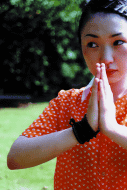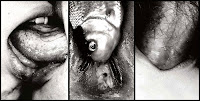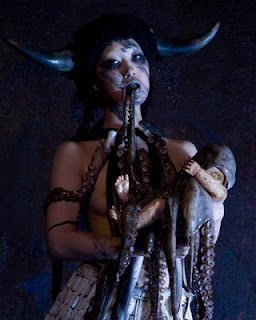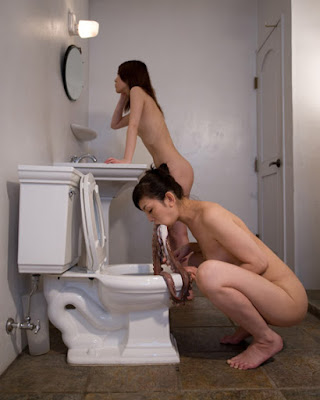This is a brief sketch of three Japanese photographers that probably shouldn't be included in the same conversation, much less the same blog. While the latter two, Araki Nobuyoshi and Amano Daikichi, may share some common grounds, each of the three have an entirely unique approach to subject matter. The one connecting thread, however, is that all three are best known for their choice of Japanese women as subjects. Any one of the artists' work could serve as a thesis on the role of women in art, and especially in the art of Japan. Perhaps each can re-emerge in a broader context on these virtual pages in future posts.
Araki Nobuyoshi is a long-established, well-known presence behind the camera, with multiple monographs about his work, and over 300 exhibiting it. Amano Daikichi has been a hot topic on blogs about art and the outré , but is relatively less known. Fujimoto Aki is virtually untraceable; a veritable mystery girl who will hopefully receive wider attention in the coming years. (Though, one hopes, not so much attention as to end up like my favorite Japanese photographer, Sugimoto Hiroshi, emblazoned on a new release by U2.) At any rate, there seems to be an inverse relationship between my interest in the photographer, and the amount of available information on the Web and in print: in a google search Fujimoto has virtually nil, Araki is in abundant supply.
Fujimoto Aki (藤本昌 )
My first (and favorite) time seeing the work of Fujimoto Aki was on a trip to the Seattle Asian Art Museum. It was a shot featuring the same subject to the left, but a close-up head-and-shoulders shot, the girl facing straight toward the camera, illumined by sunshine, eyes upwardly askance in thought. The piece was entitled "Hmmmmm", and had I known it to be unavailable online, I would have ventured an illicit shot with my own camera. The photo is crisp and alive and full of youthful energy, as is the one to the left, entitled "I think".
To date, so far as my monolingual skills (and help from a Japanese friend) can tell, Fujimoto has only appeared in one print anthology, and a dozen or so shows. The book, Tokyo Girls Bravo, is an anthology of work by contemporary female artists compiled by manga-art superstar Murakami Takashi. Its artists, who are previewed in a slide on the page of the Marianne Boesky Gallery, also features work by the loveable Yoshitomo Nara, along with a dozen other artists unbeknown to me.
Discussions of Fujimoto's work inevitably bring up the issue of kawaii (可愛い), or the art of cuteness. A photo of a small fawn, carefree girls lost in playful reverie or drifting along on a swan. These are the topics of Fujimoto's pieces--an honest depiction of innocence and nostalgia. I remember reading some years back (in the Wall Street Journal, of all places) about the Little Bo Peep phenomenon in modern
 Solo Swan (2003)
Solo Swan (2003)Untitled (2003)
***********************************************************************
 Araki Nobuyoshi (荒木 経惟) goes hand in hand with discussions of art and morals. There are of course detractors, as well as those who claim his art is somehow above or beyond morals, or (predictably) "misunderstood". I'm skeptical of giving artists a free card in moral assessment. His work is what it is: bound and gagged women, objectified and prodded with dildos, tied up or positioned in other degrading acts. But no simple judgment, positive or negative, captures the span of his work. In some photos the women look pleased, in others empowered, still in others abused, degraded, angry. It is not that I hold Araki outside the pale of moral judgment; it is just that a simple statement can't account for his entire oeuvre. One thing is clear, however: his personality is known to be that of a hyperactive kid, in love with the world and exploratory of emotion, a persoanlity that has attracted the likes of Bjork (he shot the photos on her remix album Telegram), Lady Gaga, and hordes of Japanese literati, among others.
Araki Nobuyoshi (荒木 経惟) goes hand in hand with discussions of art and morals. There are of course detractors, as well as those who claim his art is somehow above or beyond morals, or (predictably) "misunderstood". I'm skeptical of giving artists a free card in moral assessment. His work is what it is: bound and gagged women, objectified and prodded with dildos, tied up or positioned in other degrading acts. But no simple judgment, positive or negative, captures the span of his work. In some photos the women look pleased, in others empowered, still in others abused, degraded, angry. It is not that I hold Araki outside the pale of moral judgment; it is just that a simple statement can't account for his entire oeuvre. One thing is clear, however: his personality is known to be that of a hyperactive kid, in love with the world and exploratory of emotion, a persoanlity that has attracted the likes of Bjork (he shot the photos on her remix album Telegram), Lady Gaga, and hordes of Japanese literati, among others.Araki was born in 1940s Tokyo. A quote from the astounding Araki by Araki: The Photographer's Personal Selection 1965-2002 illustrates the enigma at an early age:
"...[A]ll of my work has a bit of the whiff of death. When I was a child, my playground was the local graveyard! And then the pleasure quarter, the Yoshiwara, was close by too, so there was the smell of whores as well. Do you know the Yoshiwara Funerary Tower? This was a temple--a so-called throwaway temple--where the bodies of unknown prostitutes were dumped. That was the sort of place I played in as a kid, so you can see I've been saturated with Death and with Eros from an early age. Nothing I can do about it."
After going to work for the advertising agency Dentsu, Araki met his wife and lifelong muse, Yoko. The two were close enough for comparison with Dali and Gala, though it was apparently an open relationship: with much gusto, Araki photographs himself nude alongside or in intercourse with innumerable women, often capturing his subjects at the height of ecstatic orgasm. In addition to sex and bondage, his other themes include flowers, toy dinosaurs and stuffed lizards, and photography of children. In fact, it was a particularly scandalous photo of a young girl, shirtless in bed with the sheet invitingly thrown back, that first brought Araki to my attention, as it is the cover of John Zorn's album Taboo and Exile. Though argued by Zorn to be placing the burden of perspective on the viewer, the collection of photos in Araki's portfolio show little that distinguishes the hyper-erotic depictions of mature (and older) women from those of the children, one of which is a close-up of a teary-eyed young girl with a wounded look on her face, possibly the same girl from the bedroom picture. Again, those morals.
The darker side of Araki's photography, or however you want to put it, at least counterbalances the deeply emotional, often nostalgic, aura that surrounds most of his work. His marriage to Yoko is lovingly documented from their beginnings (including graphic depictions of their honeymoon) to her death from cancer in 1990. Often pensive, and ever enamored by the activity of ordinary people (many of his earlier shots are taken with a hidden camera), Araki's photography captures the joys of life and the pangs of contemplating mortality. Sex is undoubtedly the glue that holds the two together in his worldview, and his palette of concupiscence is overwhelming diverse, at times playful but more often than not brutal and unrestrained. One may suspect that the female sex is so powerful a force to Araki that he feels the need to bind it up or stuff it in a suitcase, a hop and a skip from violence and supression in the wrong hands, but perhaps the ultimate homage by others' estimations. The sado-masochist underground (a favorite subject of Japanese noise artist Akita Masami (Merzbow)), mixes with a history of oppression and the relatively permissive attitude of both rape and schoolgirl fetishes in modern Japan in quite disturbing ways. But Araki just grins and tweaks his El Diablo mustache before snapping away a dozen or more photos from his self-described "workroom of shame".
************************************************************
If Araki Nobuyoshi views women as an overpowering sexual force that must be contained, then Amano Daikichi seems to looks at women as slightly repulsive, oddities to be dissected and internally explored (by amphibious proxy) and ultimately buried in slimy sea creatures and other vermin. His work involves beautiful women, often in blood-red lipstick and dark eye shadow, strangulated and enveloped by octopi, often times the tentacles wrapped around their throats and penetrating their mouths (or other bodily orifices). Some of his less risqué pieces can be seen on his website, but it is undoubtedly his work as a self-professed pornographer that has earned him infamy. His pornography studio, Genki Genki (it has some sort of feel-good meaning), documents the most outlandish and disgusting acts your humble narrator has ever been privy too. Women's bodily orifices forced open with medical equipment to allow newts, roaches and worms to enter and exit at will, their surrounding areas smeared with blood, moss and animals' organs. As art, and pornography as art, is established on the premise of one-upping its predecessors, I shiver to imagine the next stage of evolution.
In interviews, Amano styles himself as a caterer to the public's fetishistic requests, less an artist of originality than a photographer working on commission. From his own perspective it is all in good fun, driven exclusively by a curiosity to see, feel and smell these creatures in erotic contexts. He has hinted that his models are more comfortable with the set pieces than he himself. (He does, however, profess to trying first hand any acts to which the girls are subjected. Oh, and animal lovers take note, all creatures killed in production are eaten after shoot.) But this projected naivete is hard to reconcile with statements like "unusual looks and voices of women in fear cause sexual arousal to some people", and advertising lines such as "the sacrificed helpless victim of the strangulation". Amano's work brings up the age old question concerning the link between art (or porn) that pushes the boundaries of established taste, and the instigation to violence or dehumanization which it may entail. Behind the scenes, you can see the girls from the photos and videos patiently looking on as crew insert baby eels into their anus, or even having a laugh while being smeared with frog blood. (In the video mentioned below, some of the girls are seen playing with the creatures like pets, or flashing the omnipresent Asian girl-peace sign for the documentary camera.) But in the finished product their faces are twisted in a grimace, their eyes wet with the look of the victimized. We acknowledge the right of an artist to explore any and all depths of the psyche, but what of their responsibility for the shift in society's mind toward women, or the violence it may invoke? Are we prepared to stoke the curiosity of the latent rapist in the name of artistic freedom? Not an easy question to answer.
In fact, Amano's work is thought-provoking on many levels. The art work itself is morbid and disturbing, but in a video interview he insists that he is a pornographer and not an artist. (The Vice Guide video gives the clearest picture of the reserved and mildly awkward Amano. The critical bits are blurred out, but you get plenty of the picture.) It's obvious that morbid curiosities, especially concerning sex, are probably timeless. Most sources inevitably draw the connection to Japanese shunga (春画 literally "Spring painting"), most famously depicted in Hokusai's Dream of the Fisherman's Wife. And it's perhaps not a misconception to say that this tradition has deeper roots in Japan than in most other countries. But how do we reconcile it with modern mores imbued with the philosophy of feminism? No one can deny that women the world over share a history of oppression, and still suffer from acts of sexual violence. But sweeping the darker side of humanity under the rug doesn't make it go away either.
In fact, the questions this type of art raises turn the sensitive modern male in circles. The girls in the video seem to be having fun, and there is no evidence they are forced into Genki Genki studios. The same is true for Araki Nobuyoshi's models. On the contrary, rather than being put off, women have been drawn toward figures like Araki and are just as fascinated by Amano as he is of them. His interviewer for the Toro Magazine article above is a woman, and she shows no sign of being offended or angered. The feminist movement takes issue with men viewing women as weak and fragile, positing themselves as their protectors. So when men are more vocal in their outrage at the objectification of women's bodies than are women (with obvious exceptions), what does it say about pre-conceived gender roles? Yet at the same time, if women now view playing the role of the victim in porn or offering themselves as passive objects to be manipulated by the camera an act of empowerment, is it not a win-win situation for men? It's clear that artists such as these photographers play a key role in bringing such questions to the table. One only wonders what Fujimoto Aki has to say about it.















